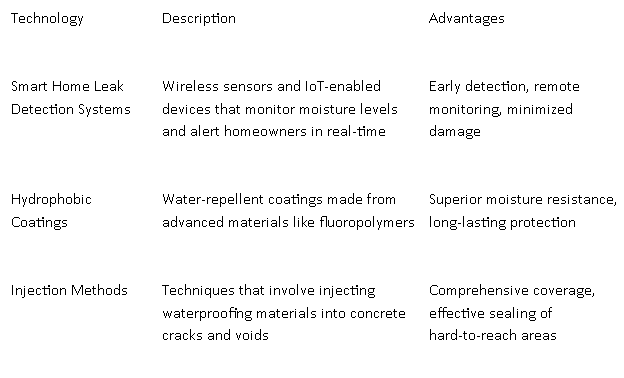A dry basement serves as a sanctuary – safeguarding your home’s structural integrity, indoor air quality, and peace of mind. However, far too many homeowners overlook the telltale signs of moisture intrusion until it’s too late. Over 60% of basements in existing homes have moisture problems, making waterproofing an essential investment.
In this comprehensive guide, we’ll explore practical, proven strategies to safeguard your remodeled basement from leaks and water damage, ensuring your home remains a fortress against the elements.
I. Assessing Your Basement’s Waterproofing Needs
A. Identifying Signs of Moisture and Leak Problems
The first step in waterproofing your basement is recognizing the early warning signs. Visual cues such as water stains, mold growth, and the presence of efflorescence, a white, chalky residue on walls, can indicate moisture issues. Even a musty smell or excessive humidity in your currently underutilized basement should raise red flags. Their trained eye can identify underlying problems that may not be immediately apparent, and their recommendations can effectively guide your waterproofing efforts.
B. The Role of Professional Inspections
While you can perform a preliminary assessment yourself, it’s wise to enlist the expertise of a local waterproofing professional. Their trained eye can identify underlying problems that may not be immediately apparent, and their recommendations can guide your waterproofing efforts more effectively.
For instance, the record-setting spring rains in May 2020 overwhelmed rivers across Illinois, leading to flooded basements for thousands of residents including Naperville. Such incidents highlight the importance of proper waterproofing measures to prevent costly repairs and potential health hazards from mold growth. So, a basement remodel Naperville with a thorough inspection is crucial if you’re considering remodeling or finishing an unfinished space.
II. External Waterproofing Strategies
Preventing water from ever reaching your basement is the first line of defense – and it all starts outside your home.
A. Proper Gutter and Downspout Maintenance
Well-maintained gutters and downspouts are essential for directing rainwater away from your foundation. Neglecting this simple task can lead to water seepage issues and eventual basement leaks. Regularly clear debris from your gutters, and consider installing gutter guards to minimize maintenance. Ensure downspouts discharge water at least six feet away from your home’s perimeter.
B. Landscape Grading and Drainage Solutions
The slope of your yard plays a critical role in basement waterproofing. Ideally, the ground should slope away from your foundation, preventing water from pooling near your home’s base. If the grading needs improvement, consider regrading or installing drainage solutions like French drains or footing drains to channel water away from your basement effectively.
C. Exterior Waterproofing Coatings and Membranes
For enhanced protection, consider applying waterproof coatings or membranes to your basement’s exterior walls. These specialized materials act as barriers, preventing moisture from penetrating the concrete. While this can be a DIY project for some homeowners, it’s often best to hire professionals for proper application and long-lasting results.
III. Internal Waterproofing Measures
Even with external waterproofing measures in place, some moisture may still find its way into your basement. These internal strategies provide an additional layer of protection.
A. Sealants and Interior Coatings
Applying waterproof sealants or coatings to your basement’s interior walls and floors can help prevent water damage from seepage or condensation. These cost-effective solutions are suitable for DIYers, but proper surface preparation and application techniques are essential for optimal performance.
B. Sump Pump Installation and Maintenance
A well-functioning sump pump is crucial for preventing basement flooding, especially in areas prone to heavy rains or high water tables. Investing in a reliable sump pump and ensuring regular maintenance can save you from costly water damage repairs down the line.
C. Dehumidification Techniques
Excess humidity in your basement can lead to mold growth, musty odors, and other moisture-related issues. Proper ventilation and the use of a dehumidifier can help maintain healthy humidity levels and prevent condensation buildup on surfaces.
IV. Advanced Waterproofing Technologies
As technology evolves, so do our options for basement waterproofing. These cutting-edge solutions offer additional peace of mind and convenience. While traditional waterproofing measures like sealants and sump pumps offer reliable protection, advancements in technology have introduced innovative solutions that provide added convenience and peace of mind.
The following table compares some of the cutting-edge waterproofing technologies discussed in the next section:

These advanced waterproofing technologies, along with ongoing research and development, offer homeowners enhanced protection and convenience in safeguarding their basements from moisture-related issues.
A. Smart Home Solutions for Leak Detection
Wireless sensors and Internet of Things (IoT) innovations have revolutionized leak detection systems. These smart home solutions can alert you to potential water issues in real time, allowing for prompt action and minimizing damage. From moisture sensors to smartphone-connected monitoring systems, these technologies offer an additional layer of protection for your basement remodeling project.
B. Modern Materials and Techniques
The waterproofing industry is constantly evolving, with new materials and techniques emerging to enhance the effectiveness of traditional methods. Hydrophobic (water-repelling) coatings, for instance, can provide superior protection against moisture intrusion. Additionally, innovative application techniques, such as injection methods, offer more comprehensive coverage and longer-lasting results.
V. Long-Term Maintenance and Monitoring
Waterproofing your basement is an ongoing process, not a one-time fix. So, even after completing a basement remodeling project, regular maintenance and monitoring are essential to ensure the continued effectiveness of your waterproofing systems.
A. Routine Checks and Upkeep
Schedule seasonal inspections to check for any signs of water damage, cracks, or other issues that may compromise your average basement project’s waterproofing. Additionally, perform routine maintenance tasks like cleaning gutters, checking sump pumps, and ensuring proper ventilation.
B. Addressing Emergent Issues
If you notice new leaks or water damage, don’t hesitate to take action. Address any issues promptly to prevent further damage and potential structural problems. In some cases, you may need to consult a professional to determine the root cause and implement the appropriate solutions.
Conclusion
Protecting your basement from water damage is an investment in your home’s longevity, safety, and value. By understanding your basement’s waterproofing needs, implementing a combination of external and internal strategies, embracing new technologies, and committing to ongoing maintenance, you can safeguard this vital space from the perils of moisture intrusion.
Remember, every home is unique, so consider consulting a professional to tailor the best waterproofing plan for your specific situation. Prioritize waterproofing now, and enjoy a dry, worry-free basement for years to come.
Published by: Holy Minoza






